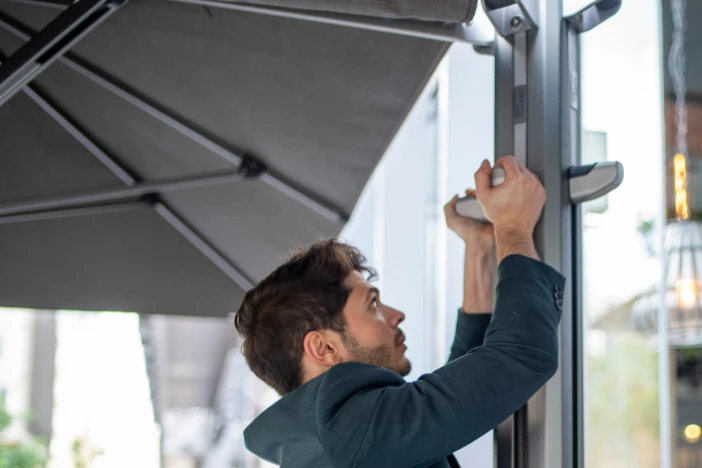
Operating your shade and wind performance
The look of a patio umbrella is easier to judge than how well it works or how it stands up to wind. You might not love the idea, but it would be wise to do some homework. Who doesn’t like reading product manuals, right? Many luxury brands have videos that show how to use their shades. Some even conduct wind tunnel tests and stress tests.
How easy is an umbrella to use?
Whether you land on a market or a cantilever umbrella, evaluate how easy it is to operate the shade. That depends largely on the size of the umbrella, its functional characteristics, the outdoor environment and your activity. Every design has pros and cons with different options available within even the same model. Carefully consider each before making a selection.
Opening, Lifting & Closing
Small center pole umbrellas can be opened, raised and closed fairly easily by hand. Their lightweight canopies can usually be lifted with one hand while the other inserts a pin to secure it into place. It becomes more challenging with larger canopies that weigh more and may be higher off the ground (tough for shorter people). In those instances, crank mechanisms or pulleys are more efficient. Most side pole umbrellas use levers or cranks to open their canopies. Others have gas-assisted technology to deploy oversized shades.
Rotating
If you plan to rotate a cantilever umbrella canopy to shade adjacent areas (e.g. lounge seating and a dining set or outdoor kitchen), you might opt for a model that has a lever mechanism. Many side post umbrellas can rotate 360 degrees. However, without something to hold, twisting the frame or moving the canopy can be hard.
Tilting
You can tilt the front edge of many cantilever umbrellas. To do this, raise the canopy to less than its full height. You can use a crank, handle or lever lift for this. A few even tilt side to side with a slight adjustment. These mechanisms make it relatively effortless. Market umbrellas can be tilted by turning a crank, twisting a collar around the pole or pressing a button near the central hub.
The first two options are easy to manage. However, you must pay attention to the mechanism’s height. This is important if you want to use the umbrella through a hole in an outdoor dining table. Tilting with a push button can be a bit harder. You need to hold the canopy with one hand while you release the catch with the other. The button can also pinch your finger or thumb as it locks back into place if you’re not careful.
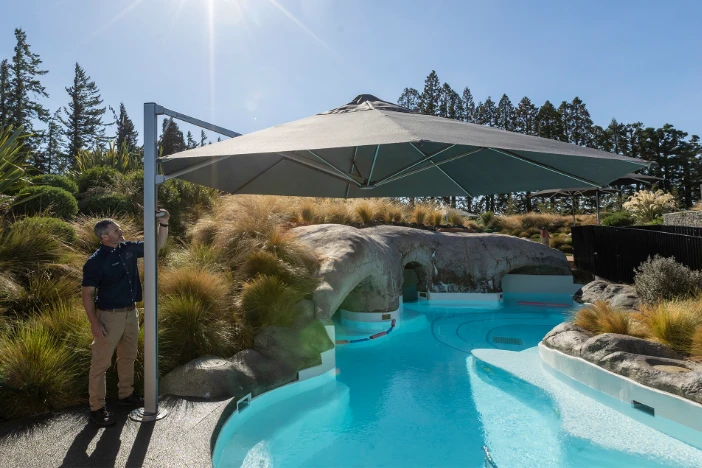
Covering
Market umbrellas are a breeze to protect using sleeve-like weather-resistant covers. They simply slide over the closed canopy from the top and secure the bottom around the pole via a snap or drawstring. Side pole umbrellas may have protective covers that wrap around both the post and collapsed canopy or just the canopy. The former has the added benefit of creating an aesthetically pleasing minimalist profile when out in the open. The latter, however, leaves the covered canopy hanging like a bat from the horizontal arm.
Most cantilever umbrella covers have an open seam. This seam helps accommodate the framework as you wrap the canopy. You can seal it with velcro or snaps. If you don’t have a weatherproof cover, check if there is a custom one for your umbrella. You can also look for a generic option that fits.
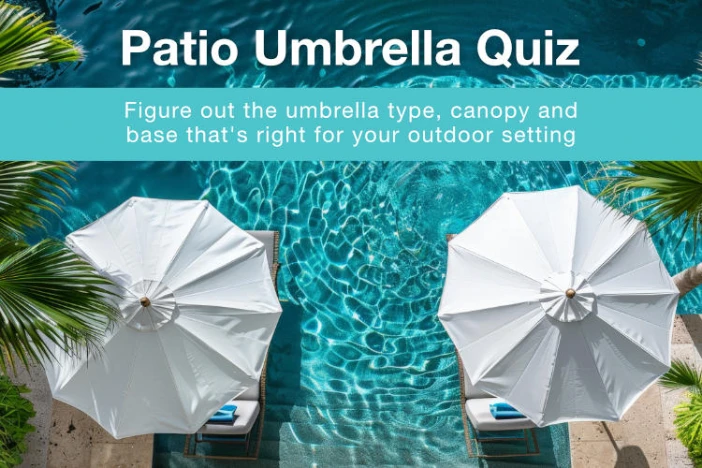
Moving
Portability mainly depends on how heavy your garden umbrella is. It also depends on whether your freestanding base has wheels. You can move market umbrellas by taking off the pole and canopy from the base. Then, move the base and put the pole back into the base tube. The wheels are typically engaged by just tipping the base in the direction of the axle.
However, large center post umbrellas and most side post umbrellas weigh too much or are too awkward to easily move piece by piece. In those cases, a wheeled base is needed. However, it can still be hard to move across a deck, patio, or poolside area. The wheels lock into place to prevent movement when the umbrella is in use. Outdoor umbrellas that are attached to the ground usually stay in place. However, they can be unscrewed from their plates if needed.
Quick steps – Relocating outdoor umbrellas*
Market Umbrella
Small to mid-sized center pole umbrellas can be moved easily by one person. However, larger models may need two people to handle them safely.
- Close the canopy & secure it
- Loosen tube bolts
- Slide pole out of tube
- Lay umbrella near new location
- Roll or lift base to new location
- Insert pole into tube
- Tighten tube bolts
- Remove securing & open canopy
Cantilever Umbrella
Offset umbrellas are heavy and hard for one person to move alone. It is best to have two or more people to help for safety.
- Close the canopy & secure it
- With the second person holding the mast in place, remove the mounting bolts
- Together, move the umbrella and lay it near the new location
- Unlock wheels and roll base to new location or remove base weights until it’s light enough to roll or carry there
- Lock wheels or bring removed weights to new location and add back to base
- Together, lift the umbrella upright
- Position it so the mounting holes align
- With the second person continuing to hold the mast in place, insert and tighten mounting bolts
- Remove securing ties & open canopy
*These are general guidelines. Always defer to a manufacturer’s own operational instructions for your specific outdoor shade.
Storing
Most center pole umbrellas store easily because the base is the only thing that takes up horizontal floor space. The pole and collapsed canopy are relatively narrow and only take up vertical space.
Offset umbrellas, however, can vary greatly in storage requirements. Some have fixed frames with arms that remain extended even when the canopy is closed. Others have arms that collapse into the upright frame, thereby minimizing the horizontal space required to store them. Some designs let you take off the canopy completely. This makes it easy to store without moving the frame or base.

How important is wind speed for sun umbrellas?
The wind condition of your environment is a critical factor in evaluating outdoor umbrellas and materials. Calm air or light breezes can work with almost any type of shade. However, strong winds need stronger designs. They require better materials and more flexibility. You also need stronger mounts and heavier bases. As wind gusts get stronger, it’s important to close and secure canopies quickly. This helps prevent damage and makes your umbrella last longer.
Factors that influence wind-resistance
- Material Strength & Durability
Sturdy powder-coated aluminum and steel frames and poles help umbrellas resist strong winds. Heavy awning or marine-grade canopies made of solution-dyed acrylic and polyester are tear-resistant. - Canopy Venting
Single and double vents in canopies allow wind to pass through, reducing uplift pressure and improving wind performance. - Base Design & Weight
Large outdoor umbrellas require heavier bases than small ones. Cantilever shades need more weight than center pole models. Wider bases are more stable than narrower ones of the same weight. - Rib Construction & Reinforcement
Fiberglass ribs bend in high winds, while maintaining support. Ribs, hubs and their connection points should be made of durable materials to withstand sudden gusts. Reinforced canopy pockets and stainless steel grommets and fasteners help to secure canopies to their rib assembly. - Canopy Shape
The lower the canopy profile, the more aerodynamic it tends to be and better able to handle higher winds. Round canopies may be slightly better in windy conditions due to the symmetrical distribution from the central hub.
Beaufort Scale – Measuring Wind Speeds & Their Effects
The most common reference for outdoor umbrella makers to measure wind tolerance is the Beaufort wind force scale. It was developed in 1805 by Irish hydrographer Sir Francis Beaufort to help sailors estimate wind conditions at sea. This scale uses visual observation instead of scientific tools. It helped to make subjective views more standard. Later, land observations were added and measurable wind speeds were assigned to the descriptions. [Forrester 1986]
Most patio umbrella brands show the Beaufort scale level. They also list the safe wind speed ranges for each product. This includes different sizes and shapes. Many put their umbrellas through grueling wind tunnel tests to determine their wind resistance (see video below). These tolerances are usually found on specification sheets or in warranties. Product damage coverage relies on proper use and maintenance in certain conditions. Most manufacturers suggest that you secure or store umbrellas during severe weather or high winds.
Beaufort Wind Scale Chart
Below are the Beaufort scale levels and their corresponding descriptions, wind speeds and land conditions.
| Level | Description | Wind (mph) | Land Conditions |
|---|---|---|---|
| 0 | Calm | 0-1 | Smoke rises vertically |
| 1 | Light Air | 1-3 | Wind direction is indicated by smoke drift but not wind vanes |
| 2 | Light Breeze | 4-6 | Wind is felt on the face; leaves rustle; vanes begin to move |
| 3 | Gentle Breeze | 7-10 | Leaves and small twigs are in constant motion; light flags are extended |
| 4 | Moderate Breeze | 11-16 | Wind raises dust, leaves and loose paper; small tree branches move |
| 5 | Fresh Breeze | 17-21 | Small trees in leaf begin to sway |
| 6 | Strong Breeze | 22-27 | Larger tree branches move, whistling is heard in telegraph wires; umbrellas are used with difficulty |
| 7 | Near Gale | 28-33 | Whole trees move; resistance felt when walking against wind |
| 8 | Gale | 34-40 | Twigs break off trees; generally impedes progress |
| 9 | Severe Gale | 41-47 | Slight structural damage occurs; shingles blow off roofs |
| 10 | Storm | 48-55 | Seldom experienced inland; trees broken or uprooted; considerable structural damage |
| 11 | Violent Storm | 56-63 | Very rarely experienced inland; accompanied by widespread damage |
| 12 | Hurricane | 64+ | Widespread destruction |
Look for certifications to verify manufacturer claims
Carefully review product information and look for objective third-party certifications to verify manufacturer claims of safety, quality and durability. Marketing claims such as “wind-resistant” and “wind tested” are vague and lack standards. Certifications from reputable organizations such as TUV, ISO and ASTM ensure:
- Actual wind tests have been conducted
- Testing methods are consistent and replicable
- Results are benchmarked against measurable criteria
Certification Standards
Here are a few certifications to look for:
- TUV (Technischer Uberwachungsverein)
TUV certification indicates that a product has undergone independent safety testing, covering key areas like mechanical durability, wind resistance, and UV protection. The TUV mark is trusted in Europe and is becoming known worldwide. It assures consumers that a product is reliable and meets high safety standards. - ISO (International Organization for Standardization)
ISO standards promote global consistency in manufacturing and testing, helping ensure uniform material quality, effective process control, and long-term product reliability. While not always focused specifically on wind resistance, they support overall performance and durability through standardized practices. - ASTM International (formerly American Society for Testing and Materials)
ASTM develops targeted standards for outdoor furniture and materials, including patio umbrellas. Relevant guidelines cover performance (ASTM F1988), UV resistance (ASTM G155), and fabric strength (ASTM D5034 and D2261). These standards help ensure that umbrella fabrics resist tearing and that structural components like poles remain durable under stress.
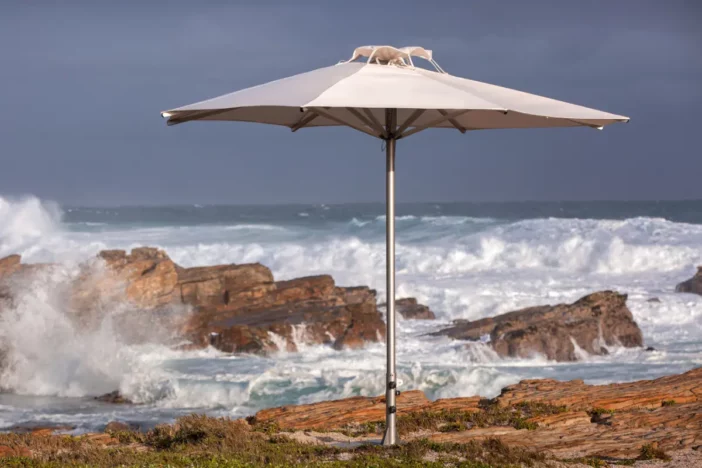
Additional deck umbrella wind tips
- Evaluate your environment before buying
Check your specific microclimate. This includes open areas, coastal regions, sheltered patios, or wind tunnels from tall buildings. These factors affect the wind rating you need for your umbrella. - Review warranties
Wind damage is often excluded beyond specified limits. Understand the warranty details and follow the manufacturer’s wind-use guidelines to avoid voiding coverage. - Consider anchoring mechanisms
In windy locations, opt for a permanent mount rather than a freestanding base. You can also use specialized securing straps to stabilize the umbrella or keep the canopy closed during high winds. - Identify signs of wind stress or damage
Watch for excessive swaying, bowing ribs, or a flexing pole—these are signs your umbrella is struggling in the wind. Address issues promptly to prevent breakage. - Maintain your shade for wind resilience
Regular maintenance improves long-term durability. Check for loose bolts, lubricate moving parts, and repair or replace torn canopies to ensure optimal performance.
Develop good habits and play it safe in iffy weather
The best way to keep your outdoor umbrella in good shape is to use it correctly. You should also check it often for any signs of stress or damage. Regardless of the wind rating, we advise that you exercise caution when winds kick up and the weather turns nasty. You will enjoy the shade and save time. You will also avoid problems and save money on repairs or replacements. Read the final section of this guide to get some thoughts on maintenance and cleaning.
Guide Sections
References
- Forrester, F. H. (1986). How strong is the wind? The origin of the Beaufort Scale. Weatherwise, 39(3), 147-151.


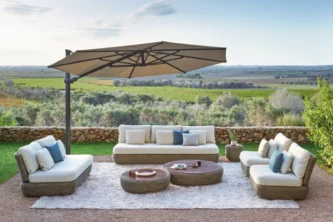
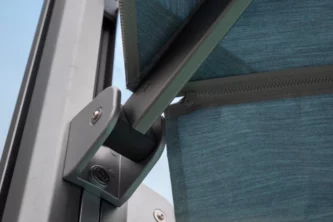
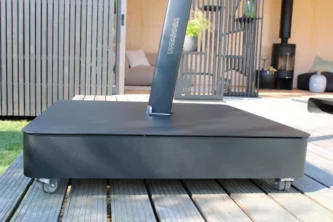
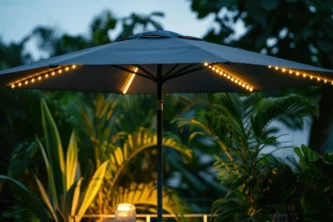





Leave a Reply